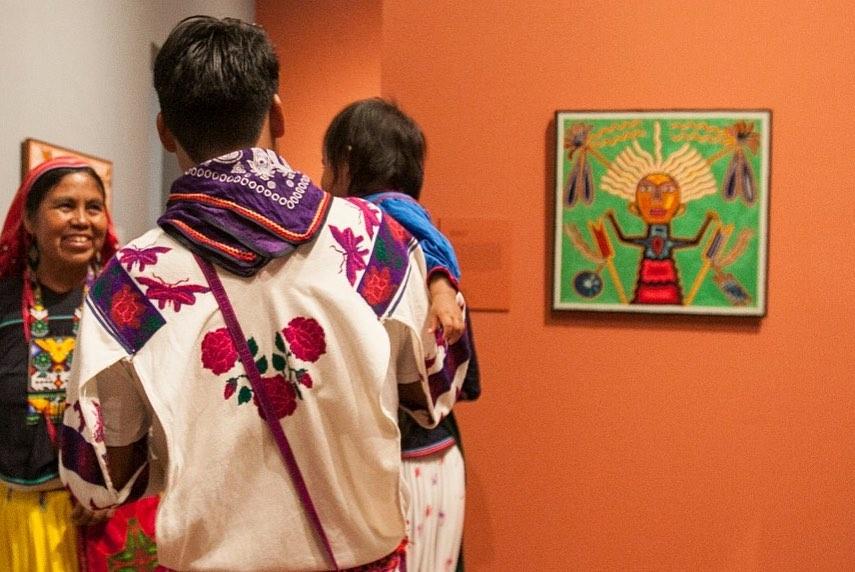Multimedia & Curation

Juan Negrín's dedication to Wixarika art, culture, and territory was catapulted by a small exhibit of yarn paintings organized by Franciscans in Zapopan in 1970. An artist himself, his intentional search for the most creative Wixarika yarn painters in Nayarit and Jalisco led him and his Wixarika compadres to create an unparalleled collection of yarn paintings. Over the span of the next two decades (1970-1990), ‘Uxa Yikaiye José Benitez Sánchez, Tutukila Tiburcio Carrillo Sandoval, Ketsetemahé Teukarieya Guadalupe González Ríos, Xitaima Lucía Lemus de la Cruz, Tauxi Mutuani Juan Ríos Martínez, and Yauxali Pablo Taizán de la Cruz would all create unique and remarkable works of art consisting of various dimensions and illustrating with brilliance the oral history that comprises Wixarika cosmogony. During this time, Juan and Yvonne Negrín curated a collection that includes audio recordings of the artists narrating more than one hundred works of art. Of note was Juan Negrín’s subsequent laborious work of transcribing and editing these recordings to provide explanations for a great majority of the paintings in the collection.
As a testament to his dedication to Wixarika arts, in 1976 Juan Negrín established a non-profit foundation in Guadalajara, Jalisco dedicated to sacred and traditional Wixarika art with a board of directors made up exclusively of Wixarika mara'akate (chanters and spiritual authorities). With the support of Cultural Survival, this effort led to the creation of more than one hundred stone sculptures (tepari and memute) that depict our many collective ancestors.
Despite the brilliance of the yarn paintings, textiles and sculptural works, hierarchies within the art world have continuously minimized the ability for Indigenous artists to find support and visibility beyond folk arts markets. These exclusions led Negrín to promote Wixarika artists by curating a series of groundbreaking exhibits in the late 1970s through the 1992 in Mexico, Europe and the United States. Further, Negrín helped find a network of allies that generously showcased Wixarika yarn paintings in galleries in order for the artists to be able to sell their work at a higher value than in the traditional tourist markets of Tepic, Puerto Vallarta, and elsewhere.
Shortly before Juan's death in 2015, the Musée d’Arts Africains, Océaniens et Amérindiens in Marseilles, France, held the first exhibit of our yarn paintings in many years, accompanied by a catalogue with French explanations to these masterworks. In homage to Juan's work, in 2017, his daughter Diana Negrín curated a collection of photographs at the Museo de la Alhóndiga in Guanajuato as part of the annual Festival Internacional Cervantino. And, in 2019, we were able to coordinate the first large scale exhibit in thirty years at the Museo Cabañas in Guadalajara and through it, publish a major trilingual catalogue, Grandes maestros del arte wixárika, edited by Diana Negrín and co-published by the Wixarika Research Center, the Secretary of Culture of Jalisco, and Casa Wilmot. This exhibit continues to be available for touring as do individual paintings in the collection, the catalogue is available for purchase in our online store.
Finally, we also have had the pleasure to work with audiovisual materials. In the spring of 2018, we were contacted by Diana Fried who had produced a 27-minute documentary film on the carpentry and weaving workshops in the sierras that were funded and carried out by Juan Negrín through his foundation ADESMO. She has donated all her raw footage, the master audio and video tapes of her film, cassette tapes of interviews, color slides, and files. In addition to this, since 2021 Diana Negrín and Angel Urrutia have been working on a film project tracing the defense of sacred Wixarika land. With the Wixarika Research Center's online archive, we will be expanding our multimedia offerings on Wixarika art. Behind the scenes this means continuing to digitize our archival holdings and those that are gifted to us.





